In my last post, I helped guide you on a tour (real or virtual) of South Parkway from the southwest corner of the Memphis parkway system at Martin Luther King-Riverside Park to its southeast corner at Airways. Now, buckle up your seatbelts because we’re ready to turn left onto what is undoubtedly the most traveled of the parkways, East Parkway.
Once you’ve reached the bottom of a bridge that traverses both Southern Avenue and the Norfolk-Southern tracks, the leafy median picks back up and you’ll notice something different about East Parkway as compared to South Parkway – it has six lanes, three in each direction, rather than four. Indeed, East Parkway, along with its sisters Airways Blvd. and Trezevant, is one of only a very few north-south roadways that runs a considerable distance in this east-west oriented city, so the additional lanes are certainly warranted. To your right is the former Mid-South Fairgrounds, which is currently awaiting redevelopment under a variety of scenarios. Perhaps the single-most historically significant feature of the fairgrounds that remains is its entrance gates, just past Young Avenue. Built in the early 20th century, the gates retain both their elegance and muscular proportions, having greeted visitors of fairs, flea markets, wrestling matches and roller derbies for over 100 years.
To your left is the eastern edge of the Cooper Young neighborhood, with neat bungalows facing this tree-lined section of the parkway. Through this section of East Parkway, the road has a 145-foot right-of-way, a width that puts today’s 114-foot standard for major arterials to shame. This wide right-of-way provides for not only an adequate verge between sidewalk and curb to allow for mature oaks, but also a generous 30-foot median. The size of this right-of-way is graphically shown in a subdivision plat below; compare the width of the parkway to the width of the lots.
Just before you reach the next traffic signal at Central, you will find on your right Fairview Junior High, which is considered by many local architects to be the Art Deco gem of the city. A quick glance at its front façade reveals fanciful tile work, vertical pylons containing sculptures and other elements that are indicative of the Art Deco style.
The Central-East Parkway intersection was once much more cumbersome to traverse due to the Union Railway’s unfortunate alignment that happened to cross right through the heart of this intersection. When the Union Railway was laid out, East Parkway was little old 2-lane Trezevant Avenue, so I’m sure there wasn’t much of a problem crossing this intersection diagonally. But not too long after the 2-lane Trezevant became the multi-lane East Parkway, a trestle was constructed by the railroad to ease the traffic boondoggle that resulted in a diagonal railroad crossing. The solution, as seen in the photo below, was not much of an improvement (you can spot Fairview Junior High in the background).
The trestle was finally removed in the early 50s once Missouri Pacific (Union Railway’s parent) was granted access on the railroad line immediately to the north. The old tracks were pulled up and the railroad right-of-way abandoned. The old right-of-way to the northeast of the intersection was deeded to Christian Brothers College, which owned the adjacent property. The old right-of-way to the southwest of the intersection was deeded to the City, which turned the oddly shaped piece of property into the Spanish War Memorial Park. Some have alleged that it was no mere coincidence that the City placed a memorial to a war in which America defeated a Catholic nation directly across and facing one of the city’s most prominent Catholic institutions, but I digress…
The East Parkway median makes a decided change as you pass Central. You will find that the constantly changing width of East Parkway’s median, particularly at major intersections, is the quirk that differentiates this parkway from her sisters, similar to South Parkway and her jogs. For instance, the median is more than 50 feet wider north of Central than it is south of Central! Christian Brothers is on your right as you negotiate the median expansion, and has been at this same location since the early 40s. The school sold their former property on Adams to the City, which in turn tore the old school building down and constructed Juvenile Court in its place. Christian Brothers College, which at various times in its history included both a high school and a college, later became purely a four-year post-secondary institution when the high school moved to Walnut Grove in the early 60s. The school achieved university status in 1990.
Across the parkway from Christian Brothers is the Parkway Arms Apartment complex, which was built as one of the largest apartment developments up to that time in the early 1920s. The apartment units themselves, which feature sunken living rooms, remain some of the largest of their era to this day. Traveling further north, East Parkway makes another famous twist to get under a three-track railroad line that is currently co-owned by CSX Transportation and Union Pacific. The overpass is of 1940s vintage, and your journey under it not only involves a dip in topography, but also a complete disappearance of the median. Not to worry, though, the median re-emerges on the other side of the overpass.
On the north side of the overpass, you will find a few interesting things about this block of East Parkway: first, there are interstate-grade overhead signs that advertise the upcoming interchange with Union Avenue. These signs were presumably constructed since Union and the blocks of East Parkway north of Union are US Highways 64, 70 and 79. Also, the interchange with Union is exactly that – an intersection with on- and off-ramps. What makes these interstate-like ramps and oversized signs so unusual is that they co-exist with large mansions, mansions of the size we have not seen since we were on the “Cooper Parkway” section of East Parkway on our last tour. Perhaps in part because East Parkway has become such a high-traveled area along with its interstate signs and ramps, many of the owners of these mansions have constructed large masonry and wrought iron walls, which adds to the exclusive nature of this stretch of roadway.
As I’ve indicated above, East Parkway avoids our next major cross-street altogether. With one of the three lanes giving way to an on-ramp to Union, you will find the median disappears again as the parkway travels under the overpass in an hourglass formation. But once you come out from under Union, the median expands to its largest dimension in the entire Memphis parkway system. For the next half-mile or so, the median is an astounding 140 feet wide, with the right-of-way an inconceivable 250 feet. To see is to believe, so I have provided an excerpt from the subdivision plat at the northeast corner of East Parkway and Union, the area in which you will find Lindenwood Christian Church (which, by the way, is a fantastic piece of mid-20th century architecture).
The next major roadway is Madison, but you will not deal with a traffic signal here, as only the southbound lanes of East Parkway deal with a signal at Madison. Historically, the Madison and East Parkway intersection was regulated by much more rudimentary traffic devices (see below).
Just past Madison, you will see the famous “M” inside the median, which is typically adorned with flowers of the season. The “M” reminds me that the median throughout this section of East Parkway is wide enough to essentially be considered a park unto itself. On the east side of the street, you will find one of Memphis’ earliest suburban-style subdivisions, Morningside Heights. Morningside Heights proudly exhibits the second oldest subdivision entrance feature in the city (the oldest is at the entrance of Overton Park Place subdivision at Overton Park Avenue and McLean).
An examination of the plat of this subdivision reveals that, as was the case with South Parkway, the name “East Parkway” was not necessarily this roadway’s original name (see below). The plat, which dates from 1911, indicates the western boundary of Morningside Heights as “Public Parkway,” with a parenthetical “Trezevant Avenue.” Trezevant Avenue, of course, had recently been in that location before it was widened and converted to a parkway.
Halfway between Madison and Poplar, you will find an odd median for traffic to and from Jefferson Avenue. As Jefferson is two blocks north of Madison and two blocks south of Poplar, I can only assume that the parkway’s designer wished this to be some sort of focus point. Today, sadly, this median is little more than a patch of grass. Also between Madison and Poplar, you will find an eclectic array of architectural styles, ranging from Tudor to Mediterranean to Colonial. As most of the homes were constructed in the 1910s and 20s, these were typical styles for the period.
The next signaled intersection is Poplar Avenue, whose suburban sections were formerly known as Poplar Blvd. (again, see the plat for Morningside Heights above). This intersection is often cited as one of the most confusing and dangerous in the city. Part of what makes this so is the fact that the median inside East Parkway shrinks from 140 feet to a little less than 40 feet almost instantaneously as you cross Poplar. This 100-foot reduction may have been due to the City’s inability to secure the necessary right-of-way from the adjoining property owners north of Poplar. However, another theory is that the City had little interest in creating a large park-like median north of Poplar since Overton Park, itself the gem of the Memphis park system, fronts this portion of the parkway. As I stated in my last post, George Kessler, the architect of the Memphis parkways, also designed Overton Park.
A major landmark of the city lies at the northeast corner of Poplar and Parkway, First Baptist Church, a church that has probably fathered more suburban churches throughout West Tennessee than any church of any denomination in Memphis. Just past First Baptist is Strathmore, a 1920s subdivision that is unique in the number of Spanish-style houses it contains. The next subdivision after that is Eastwood Place, which also has an architectural claim to fame – it is home to one of the largest unaltered collections of large bungalows in the city. A couple of 1950s apartments buildings are next, which are in the location of an apartment building that was planned for that area in 1922, but never built.
Suddenly, the houses and trees disappear as we approach Sam Cooper Blvd. As any native Memphian can attest, this was the location of the doomed Interstate 40 through the heart of Memphis. While a non-expressway Sam Cooper was finally extended from Holmes to East Parkway a few decades after all of the structures and trees were felled, a few remnant vacant properties remain around the new Sam Cooper. Past Sam Cooper, you approach the location of another failed apartment building planned for the NE corner of East Parkway and Parkway Place: an eight-story showpiece that was even grander than the failed building above.
An article in the June 9, 1929, Commercial Appeal, read that this apartment building, which would have been one of the city’s largest, required a height variance from the Memphis Board of Adjustment in order to be built as planned. Whether that variance was rejected or the stock market crash that occurred later that year killed it, East Parkway never got its high-rise apartment building. North Parkway, on the other hand, is a different story.
In my next post: the third and final installment of the tour of the Memphis parkway system, a drive towards downtown on North Parkway.

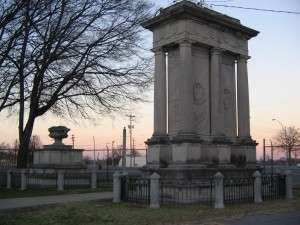
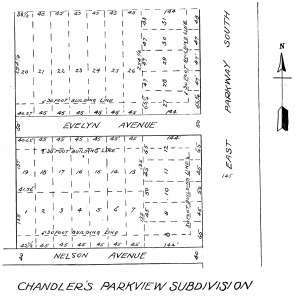
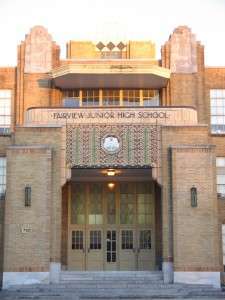
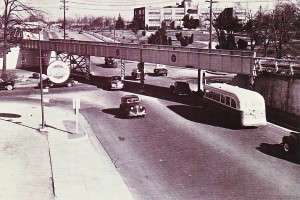
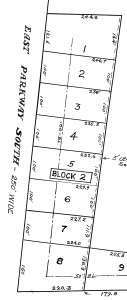
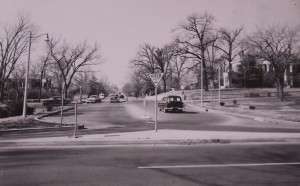
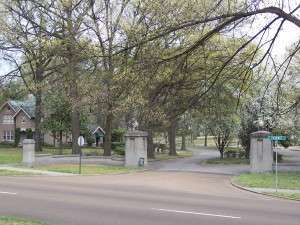
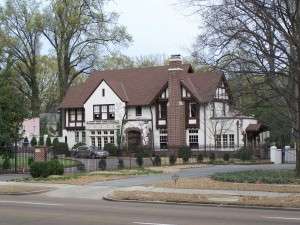
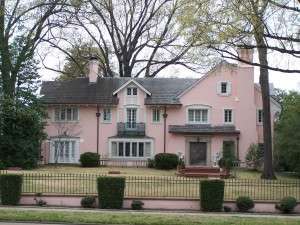
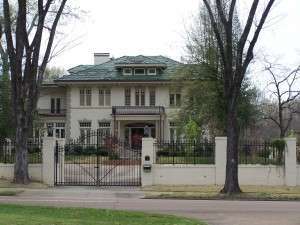
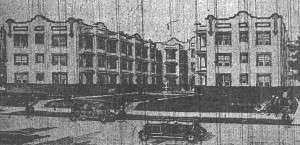
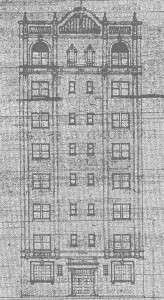



The gates at the entrance to the fairgrounds: THAT is what public art should look like! Timeless style, always impressive. See the numerous pocket parks in New Orleans or Boston or Washington with similar monuments in them.
Another great post. Love the graphics.
Question:
Why did you start the journey moving south to north? Just curious if you had a reason or if it was that you had to start somewhere.
John: Since one of the original goals of the parkway system was to connect Riverside and Overton Parks, I thought starting at Riverside going from south to north would be more historically appropriate. And anyway, driving straight towards the Pyramid at the end of the tour is much more dramatic!
-Josh
Big fan of the tour! As an architect and planner, I am not nearly familiar enough with certain sections of the city and your tour of South Parkway was very informative and fun. Your tour of East Parkway was no less educational- the unbuilt environment along East Parkway is perhaps the most intriguing. While driving “out east” the other day I made a comment to a friend that the area between Poplar and North Parkway seemed ideal for high end residential high rises (think Central Park West) considering the excellent access coupled with beautiful views of the Old Growth Forest at Overton Park. One can dream- can’t they?